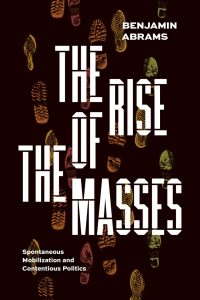Read an Excerpt from “The Rise of the Masses” by Benjamin Abrams
August 14, 2023 marks the 10th anniversary of Egypt’s Rabaa Massacre, which sparked the beginning of Abdel Fattah el-Sisi’s reign of terror. Under el-Sisi’s command, Egyptian armed forces raided two camps of protesters in Cairo—one at al-Nahda Square and a larger group at Rabaa al-Adawiya Square. This horrific massacre claimed the lives of at least 817 protesters that day and put an end to any further revolutionary prospects in the country.
The details of the Rabaa Massacre are examined in Benjamin Abrams’s new book, The Rise of the Masses: Spontaneous Mobilization and Contentious Politics, an incisive look at the drivers behind large spontaneous protests. In 2015, Abrams visited Cairo with the intention of understanding what had transpired during Egypt’s revolution and its aftermath. He found that the revolution was dead, and the violent killings on August 14 had cast a shadow over future protests.
In this excerpt, Benjamin Abrams reveals how Egypt’s Rabaa Massacre forged Abdel Fattah el-Sisi’s dictatorial terror.
Almost exactly 10 years ago, in August of 2013, a “temporary” military regime under the thumb of then Secretary of Defense (and later, President) Abdel Fattah el-Sisi held control of the Egyptian state. The regime had come to power one month earlier, after a successful coup against Egypt’s democratically elected president, Mohamed Morsi.
In response, Morsi’s supporters had taken to the streets in protest. One particular sit-in, at the Rabaa al-Adawiya mosque, had been going on for more than a month. It was el-Sisi’s decision to forcibly dispatch this sit-in on the 14th of August that would mark the beginning of Egypt’s slide into rule by terror. What transpired was a massacre.
Protesters suddenly found themselves facing machine guns, snipers, and tanks. “It was a new level, I’d never seen before . . .” one protester recalled, “I went to the frontlines, where the troops were, and people were chanting against them, very afraid they could open fire any time.”
And open fire they did, claiming the lives of at least 817, and possibly over a thousand, pro-Morsi protesters. Many more caught stray bullets.
“I got out [of the mosque], and I heard a strange echo in my ears,” one participant recalled. “I went back to the concrete where people were gathering . . . and they told me: ‘you’ve been shot’.” Twice, it transpired. One bullet—or perhaps shrapnel of some description—had only grazed him, but the other was a direct hit. His comrades rushed him to the hospital.
This was the last time my informant ever attended a protest, but the last day many of those who protested at Rabaa ever saw. One eyewitness described how they had “found the Rabaa hospital full of injured people and corpses.” “I had never seen such brutality as what I saw after Rabaa,” they surmised.
After Rabaa, protests in Egypt became a matter of life and death. Lethal force became a disquieting norm. “Whenever we started demonstrating live bullets were shot, [and] tons of people were killed,” one protester, Fouad, recalled. Meanwhile, the Sisi regime has since continued to enclose freedom of assembly, expression, and association in Egypt, co-opting the state-run media for propaganda purposes, and heavily censoring private newspapers.
Organizations once beloved for their role in overthrowing Mubarak were soon banned, and activists and organizers were arrested for participation in the 2011 protests. Even the online space has become closely monitored and controlled: in 2015 a 22-year-old law student, Amr Nohan, received a three-year jail sentence for sharing an image of el-Sisi wearing Mickey Mouse ears.
It was at this point—in the blistering summer of 2015—that I arrived in Cairo with the intention of unravelling what had transpired during the revolutionary period. I had not anticipated that, far from studying the vibrant life of a revolutionary nation, I would instead be required to fulfil the task of a mortician.
The revolution was dead, and everybody knew it. In its place was nothing short of a reign of terror.
Armored vehicles toting heavy machine guns lurked around the corners of Cairo’s city blocks. Posters, banners, and flyers with el-Sisi’s face lined the streets. Self-professed “honorable citizens” stood by, ready to report on anyone seemingly out of the ordinary. Contacts in the country advised me that the regime’s spies were everywhere. Several colleagues had been ejected from the country, and only narrowly avoided their research documents being seized, some after an unpleasant treatment from the interior ministry. Former revolutionaries, Muslim Brothers, and secular activists were disappearing by the day. Things were taking a very dark turn.
Researchers were also worried. Giulio Regeni, a colleague of mine from Cambridge, arrived in the country stalked by a looming fear that he was being watched. Things only got more desperate in the New Year. Amnesty International assessed that 3-4 Egyptians were being forcibly disappeared by authorities every single day. Shortly after the 5th anniversary of the January 25th revolution, in January 2016, I became aware of one disappearance in particular. It was Giulio.
The intricacies of what followed are now a matter of public record, so I shall retain the mantle of an academic and simply say that Giulio had been tortured to death. When his body was found at the side of a desert road his fate became remarkable because he was not Egyptian. He was in fact one of many people “picked up” by the security forces that week, and thousands more “disappeared” every year since.
“People are getting killed, and this time, brutally. All the world is seeing them getting slaughtered and no one notices,” I remember Fouad telling me during one of our interviews. His statement remains just as true today as it was then. For all the vocal interest world powers showed in Egypt’s Eighteen Days, the reaction to its Eighteenth Brumaire has been a tinnitus-inducing silence.

Adapted and excerpted from The Rise of the Masses by Benjamin Abrams, published by the University of Chicago Press. © 2023 by The University of Chicago. All rights reserved.
Benjamin Abrams is a lecturer in sociology at University College London.
The Rise of the Masses is available now from our website or your favorite bookseller.
